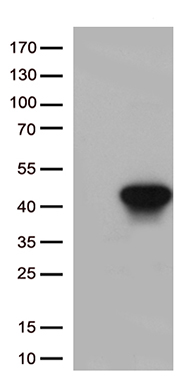HLAA (HLA-A) Mouse Monoclonal Antibody [Clone ID: OTI2D11]
CAT#: CF813378
Carrier-free (BSA/glycerol-free) HLA mouse monoclonal antibody, clone OTI2D11
Size: 5 Slides
USD 396.00
Specifications
| Product Data | |
| Clone Name | OTI2D11 |
| Applications | WB |
| Recommended Dilution | WB 1:500-1000 |
| Reactivities | Human |
| Host | Mouse |
| Isotype | IgG1 |
| Clonality | Monoclonal |
| Immunogen | Human recombinant protein fragment corresponding to amino acids 25-308 of human HLA-A (NP_002107) produced in E.coli. |
| Formulation | Lyophilized powder (original buffer 1X PBS, pH 7.3, 8% trehalose) |
| Reconstitution Method | For reconstitution, we recommend adding 100uL distilled water to a final antibody concentration of about 1 mg/mL. To use this carrier-free antibody for conjugation experiment, we strongly recommend performing another round of desalting process. (OriGene recommends Zeba Spin Desalting Columns, 7KMWCO from Thermo Scientific) |
| Purification | Purified from mouse ascites fluids or tissue culture supernatant by affinity chromatography (protein A/G) |
| Conjugation | Unconjugated |
| Storage | Shipped at -20°C or with ice packs, Upon delivery store at -20°C. Dilute in PBS(pH7.3) if necessary. Stable for 12 months from date of receipt. Avoid repeated freeze-thaws. |
| Stability | Stable for 12 months from date of receipt. |
| Predicted Protein Size | 40.8 kDa |
| Gene Name | Homo sapiens major histocompatibility complex, class I, A (HLA-A), transcript variant 1 (A*03:01:0:01), mRNA. |
| Database Link | |
| Background | HLA-A belongs to the HLA class I heavy chain paralogues. This class I molecule is a heterodimer consisting of a heavy chain and a light chain (beta-2 microglobulin). The heavy chain is anchored in the membrane. Class I molecules play a central role in the immune system by presenting peptides derived from the endoplasmic reticulum lumen. They are expressed in nearly all cells. The heavy chain is approximately 45 kDa and its gene contains 8 exons. Exon 1 encodes the leader peptide, exons 2 and 3 encode the alpha1 and alpha2 domains, which both bind the peptide, exon 4 encodes the alpha3 domain, exon 5 encodes the transmembrane region, and exons 6 and 7 encode the cytoplasmic tail. Polymorphisms within exon 2 and exon 3 are responsible for the peptide binding specificity of each class one molecule. Typing for these polymorphisms is routinely done for bone marrow and kidney transplantation. Hundreds of HLA-A alleles have been described. [provided by RefSeq, Jul 2008]. |
| Synonyms | HLAA |
| Reference Data | |
| Protein Families | Transmembrane |
| Protein Pathways | Allograft rejection, Antigen processing and presentation, Autoimmune thyroid disease, Cell adhesion molecules (CAMs), Endocytosis, Graft-versus-host disease, Natural killer cell mediated cytotoxicity, Type I diabetes mellitus, Viral myocarditis |
Documents
| Product Manuals |
| FAQs |
Resources
| Antibody Resources |
{0} Product Review(s)
Be the first one to submit a review






























































































































































































































































 Germany
Germany
 Japan
Japan
 United Kingdom
United Kingdom
 China
China






